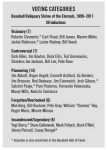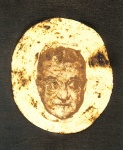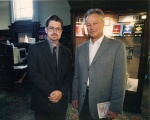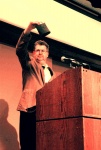Post-Cooperstown Post Modernism: The Baseball Reliquary and the Future of Nostalgia
This article was written by Don Malcolm
This article was published in The National Pastime: Endless Seasons: Baseball in Southern California (2011)
Just what is the Baseball Reliquary, anyway? There are as many answers to that question as there are multitudes contained by Walt Whitman, the Brooklyn-based author of Leaves of Grass and the first American artist to embrace the game and assimilate it into his poetic vocabulary.
“BASEBALL is America’s game: has the snap, go, fling, of the American atmosphere – belongs as much to our institutions, fits into them as significantly, as our constitutions, laws …” — Walt Whitman
 Just what is the Baseball Reliquary, anyway? There are as many answers to that question as there are multitudes contained by Walt Whitman, the Brooklyn-based author of Leaves of Grass and the first American artist to embrace the game and assimilate it into his poetic vocabulary.
Just what is the Baseball Reliquary, anyway? There are as many answers to that question as there are multitudes contained by Walt Whitman, the Brooklyn-based author of Leaves of Grass and the first American artist to embrace the game and assimilate it into his poetic vocabulary.
What Whitman did for baseball during its formative years in the nineteenth century, the Baseball Reliquary—a homeless, “virtual Cooperstown” more akin to a floating crap game than a venerable shrine— is doing for it in the twenty-first. Despite its image as a kind of “trickster anti-institution” celebrating baseball’s fringe elements, the Reliquary’s stance is richly visionary, embodying an expansive concept of baseball’s place in American culture that is as freewheeling for its time as Whitman’s was in his.
From its inception, the Baseball Reliquary—with its many programs exploring stylistic and aesthetic elements embodied in the game, with its unique inversion of the Hall of Fame’s enshrinement process (its “Shrine of the Eternals”), and with its commitment to shining a light on the underrepresented histories of the game— has defined itself as a hit-and-run organization that could carry its paraphernalia in a rucksack. (A museum without walls, the Reliquary’s collection is displayed at periodic exhibitions around Southern California, when not occupying several storage units.) Reliquary devotee Ron Shelton, writer-director of Cobband Bull Durham, and one who is deeply immersed in the game, was struck by this calculated impermanence: “It’s as if they’ve created a Hall of Fame that is really just a state of mind.”
And yet, this studied indifference to the rules of “institution-hood” has produced an alternative Hall of Fame concept that is bracing in its uncanny selection process. The voting membership of the Reliquary, year after year, has produced a virtually flawless set of inductees who represent a cross-section of baseball’s cultural and athletic concerns. Their 39 inductees (the complete list can be found in the box on page 17) have a unique breadth of coverage that transcends Cooperstown.
____
“There are two things that the Baseball Reliquary is known for,” says founder and executive director Terry Cannon of Pasadena. “We are known for being irreverent and we’re known for having all those strange artifacts.” Beginning in 1996 Cannon and right-hand man Albert Kilchesty clearly brought post-modern sensibilities to their mission. Kilchesty, an accomplished experimental filmmaker, is the organization’s brilliant but wayward archivist and historian, whose flair for the surreal is pronounced. Taking Henry David Thoreau’s “different drummer” dictum to its ultimate conclusion, Kilchesty and Cannon decided to invert the relationship of spectator and artifact from what is standard museum practice. “What if the imagination had some say in what the artifacts were?” Kilchesty suggests, with a faraway gleam in his eyes.
 What if, indeed. As a result, the Reliquary’s earliest artifacts follow this notion as rigorously as any modernist manifesto— the difference being, of course, that the items in question are as slapstick as they are surreal. Witness the Walter O’Malley tortilla, where the visage of the man who broke Brooklyn’s heart by moving the Dodgers to Los Angeles mysteriously became manifest on an oblong hunk of hand-rolled, hand-patted flour. As is often the case, though, there is something more serious at work in the Reliquary’s care- fully crafted satire. Cannon and Kilchesty, while happy to traffic in cheap laughs, provide a more substantivepayoff in their description of the tortilla’s “provenance”:
What if, indeed. As a result, the Reliquary’s earliest artifacts follow this notion as rigorously as any modernist manifesto— the difference being, of course, that the items in question are as slapstick as they are surreal. Witness the Walter O’Malley tortilla, where the visage of the man who broke Brooklyn’s heart by moving the Dodgers to Los Angeles mysteriously became manifest on an oblong hunk of hand-rolled, hand-patted flour. As is often the case, though, there is something more serious at work in the Reliquary’s care- fully crafted satire. Cannon and Kilchesty, while happy to traffic in cheap laughs, provide a more substantivepayoff in their description of the tortilla’s “provenance”:
No other item of baseball memorabilia illustrates more succinctly the complex relationship between the Los Angeles Dodgers and their Mexican American fan base than this unusual artifact—a flour tortilla bearing a remarkable likeness to former Dodger owner Walter O’Malley. Purchased from Ernesto Villafon in 1988 by Los Angeles artist and photographer Tom Meyer, who subsequently donated it to the Baseball Reliquary, the provenance of the tortilla is sketchy. According to Meyer, the tortilla was discovered by Mrs. Regina Flores, a resident of Chavez Ravine, who presented the object to her nephew, young Ernesto, shortly before her death in 1981. Villafon told Meyer that it was the sight of the Dodger patriarch’s jowly visage on the tortilla that convinced Mrs. Flores and family to abandon their Chavez Ravine home peacefully in 1959 prior to the construction of Dodger Stadium. After resettling in Highland Park, Mrs. Flores became a zealous Dodger fan, much to the amazement of her family and friends, who, claims Villafon, had never heard her express any interest in baseball. Radio carbon dating indcates that the tortilla is approximately forty years old, lending credence to Villafon’s story. Encased originally in an ordinary picture frame, Reliquary preparators delicately removed the fragile artifact and enclosed it in a glass-covered scientific mount box for display.
The early years of the Baseball Reliquary produced a small but potent set of these post-modern artifacts, each imbued with the deadpan zest of a Jacques Tati sustaining a series of meta-commentaries on the inherent silliness of institutional puffery. Sight gags are the Reliquary’s stock in trade, and many of their subsequent artifacts—the athletic supporter (“jock strap”) of Eddie Gaedel, the only midget to play major league baseball; a partially-smoked cigar discarded by Babe Ruth; and the “potato ball” used in a ruse perpetrated by minor-league catcher Dave Bresnahan—amplify this approach.
In recent years, however, the Reliquary’s exhibits have evolved from the ridiculous to the sublime. Witness, for example, the nimble merging of hard- boiled fact and freewheeling fantasy in the “Mother Teresa Baseball Forgeries”:
In April of 2000, the FBI announced that 26 Southern Californians had been indicted in what the law enforcement agency called the largest, most lucrative, and most brazen fraud ring ever busted for trafficking in phony sports and celebrity autographs and memorabilia. In a case dubbed “Operation Bullpen,” the FBI seized merchandise in California, Nevada, and other states that was designed to be sold for ten million dollars, including forged autographs of Marilyn Monroe, Joe DiMaggio, Mickey Mantle, the Marx Brothers, and Albert Einstein. The operation even produced a box of one dozen baseballs bearing the signature of Mother Teresa. “I think that pretty much says it all,” said William Gore, special agent overseeing the FBI case. U.S. Attorney General Gregory Vaga seemed particularly ap- palled by the sacrilegious implications of the Mother Teresa forgeries, as he told reporters, “To so crassly exploit Mother Teresa, a woman the world has anointed as a saint and who spent a life of heroic virtue, is unconscionable.”
“Operation Bullpen” involved undercover informants, a dummy company, wiretaps, and sixty search warrants. In just one month, the ring provided phony signatures on more than 10,000 baseballs. On the wiretaps, defendants were heard joking that Mickey Mantle and Mother Teresa had “one arm out of their graves” signing their names.
In a 72-page indictment, officials said that 50% to 90% of the one-billion-dollar-a-year memorabilia market is based on fraudulent goods. At the request of the Baseball Reliquary, federal law en- forcement authorities donated to the organization the box of one dozen baseballs bearing Mother Teresa’s forged signature to be used for exhibition purposes in order to alert consumers to the large amount of inauthentic memorabilia in the marketplace and to warn them to be cautious when purchasing autographed items.
Neither Cannon nor Kilchesty will confirm or deny the veracity of the above narrative: in fact, neither of them will cop to having written the narrative itself. When confronted, each merely points the finger at the other.
____
 The resemblance of the Baseball Reliquary to another alternative Pasadena “anti-institution,” the Doo-Dah Parade (which has been sending up the venerable city’s annual flora-laden flotilla, the Tournament of Roses Parade, since the late 1970s), began to change in 1999 with the creation of its post-modern Cooperstown, the Shrine of the Eternals, whose induction ceremony is held at the Pasadena Central Library.
The resemblance of the Baseball Reliquary to another alternative Pasadena “anti-institution,” the Doo-Dah Parade (which has been sending up the venerable city’s annual flora-laden flotilla, the Tournament of Roses Parade, since the late 1970s), began to change in 1999 with the creation of its post-modern Cooperstown, the Shrine of the Eternals, whose induction ceremony is held at the Pasadena Central Library.
That July, an anti-traditional ritual was first devised, and the first three members of the Eternals—Dock Ellis, Curt Flood, and Bill Veeck, Jr.—were inducted. Over the years the ceremonies would become more elaborate, with additional awards given to ordinary fans and often-unheralded historians, but the perfect balance of whimsy and high seriousness was captured by Cannon in what has become an iconic opening signature for the festivities: the ringing of a cowbell in honor of baseball’s most raucous and extreme fan, Brooklyn’s Hilda Chester, whose own incessant use of it was aptly described by Cannon as proof that she was “a master of the art of cacophony.”
The Shrine of the Eternals ceremony would, from that point forward, mirror that idea. The flow of events would always drift between order and anarchy. The ceremony itself was a work of performance art, with a series of participants who added their own imagination to the inchoate tapestry that emerged out of thin air.
In his introduction during that first ceremony, Richard Amromin, chairman of the Reliquary’s Board of Directors, spoke directly to the affinity between baseball and art:
…art is not pre-defined…the freedom to make aesthetic, moral and social decisions, and face the consequence of those decisions, is the essence of art. And this is where today’s honorees are true artists…they have transcended their chosen craft and exercised the freedom to make the same type of…decisions made by the greatest artists.
Thus began an induction process that, after twelve years, has built assiduously on this idea. Cooperstown would rarely be in congruence with the Reliquary voters, who recognized that their mission was to look for the forgotten, the legendary, the controversial, the visionary.
As the process evolved, those who paid attention began to see an emerging pattern in the type of individual honored by the Reliquary. “It wasn’t about statistics,” writer John Schulian notes. “It was about the impact that the person had on the game. And it was about the impact that the game had had on the person. It worked both ways.”
The induction process gained in resonance as the years accumulated. “Somehow in the midst of this initially whimsical and irreverent Hall of Fame alternative, a mysterious thread began to appear in each threesome being honored,” writer David Davis recalls. “An anonmous voter membership was suddenly creating themes and connections, adding a level of meaning that no one could possibly have expected to emerge out of such a process. It started to become mind-blowing.”
The Reliquary voters were themselves becoming artists.
“I suppose one could see it as its own form of ‘mass performance art,’” Terry Cannon suggests. “It seems as though we have defined a set of alternative categories for deserving individuals, and our voters have become locked into that process.”
“It shifts around every year,” adds Kilchesty. “But somehow, some way, the results keep blending into new shadings.”
 There is not much overlap with the Hall of Fame, as the accompanying chart shows. Only six of the 39 Eternals have plaques in Cooperstown. The other 30 represent the Reliquary’s unique agglomeration of child- like wonder and aesthetic-historical sophistication.
There is not much overlap with the Hall of Fame, as the accompanying chart shows. Only six of the 39 Eternals have plaques in Cooperstown. The other 30 represent the Reliquary’s unique agglomeration of child- like wonder and aesthetic-historical sophistication.
“Pioneers” have emerged as the most conspicuous category of honorees—often individuals who broke a significant cultural barrier in their pursuit of the game. Players either officially barred from Cooperstown (Joe Jackson, Pete Rose), shunned for cultural reasons (Dick Allen), or overlooked for reasons of historical expediency (Marvin Miller) have been embraced by the Reliquary voters.
The Reliquary’s roots in Southern California do show up in the voting results now and then, local heroes (Jackie Robinson, Jim Abbott, Rod Dedeaux, Fernando Valenzuela), natives (Bill Lee, Dock Ellis), and transplants (Lester Rodney, Kenichi Zenimura) are well represented. But the stories embedded in these baseball people’s lives, and their cultural interaction with the sport, are what make them Eternals. The formula that comes to mind has little do with whether the individual played baseball, rather, it is how that person found self-expression through interaction with the game. Simply put, each of the honorees in the Shrine of the Eternals has some combination of ad- versity, extremity, and “otherness” that has made his or her life narrative unique and praiseworthy.
“Singularity is the key ingredient, I think,” Kilchesty posits. “A member of the Eternals is one-of-a-kind, no matter how you might categorize them.”
____
The Reliquary’s most fruitful symbiosis in its evolu- tion from “puckish irreverence” to “cultural synthesis” is clearly in its association with Southern California painter Ben Sakoguchi, whose ongoing “Unauthorized History of Baseball” fully embodies the qualities discussed above: adversity (a second-generation Japanese American, Sakoguchi was one of thousands detained in internment camps during World War II), extremity (Sakoguchi regularly incorporates jarring cultural juxtapositions in his work), and “otherness” (the work strongly exhibits anti-institutional themes) are combined in an epic series of small (10” x 11”) paintings that also pay homage to the storied “orange crate art” that was once ubiquitous in California.
Fifteen years ago, when Sakoguchi began the series (which now comprises nearly 250 paintings), it appeared that the symbiosis between his work and the Reliquary project was nothing more than a happy co- incidence. Over the subsequent span of time, however, it’s clear that there has been a convergence of sensibilities.
“It was interesting how almost all of our inductees would wind up with a painting of their own,” says Cannon. “We never asked Ben to do that—we’ve never commissioned him. Ben doesn’t work that way. I like to think that it’s because we haven’t asked him that he’s found his own way to embrace our efforts. Perhaps he sees us as a variant of the type of inspiration that artists have. It’s a delicate connection to a special realm of reality.”
Sakoguchi breathes new life—an often pointedly scabrous life—into a quaint, undervalued art form. It is the essence of post-modernist artistic strategy, adding bark and bite, embodying the “snap, go, fling” that so captivated Walt Whitman (who was, after all, an avant-garde poet in his own day). The peculiar, in- definable energy that Whitman sensed in America, and that he saw exemplified in baseball, has not been severed from either the game or the nation in the time span separating his day from ours.
“It just seems that it has,” muses Cannon. “We tend to forget that baseball emerged as a major force in America at the same time that the robber barons were carving up the nation’s wealth. There’s always been that tension between myth and reality in Ameri- can culture, and baseball is right there in the middle of it all. It’s a miracle that the game hasn’t been completely sullied by corporatization, and we just want to do our part to make sure that it doesn’t happen.”
Kilchesty agrees. “No more uncritical nostalgia!” he shouts. When Walt Whitman is mentioned, he nods. “Whitman was no apologist—he was an enthusiast. He saw that art and play were vital therapies for the task of living. And baseball was where that was at for America. It still is.”
Perhaps we can best explain the emergence of this most improbable anti-institution to the continuing need for cultural evolution, and its protection against the all-too-prevalent forces of ossification. If Whitman were here today, it’s quite possible that he’d see the Reliquary, and not Cooperstown, as the embodiment of what should be celebrated about baseball and its connection with America. By inverting its uses, the Reliquary transforms nostalgia from a simple longing for the past into an engagement with the future as it rushes to greet us. Every third Sunday in July, the Reliquary’s induction day, it is Whitman’s notion of baseball as “the hurrah game” that animates the Reliquary’s singular synthesis of art and ceremony, anarchy and ritual, past and future.
DON MALCOLM received a copy of “The Baseball Encyclopedia” (first edition) for his birthday as an aging child—and the rest of the world has regretted it ever since. He edited the iconoclastic, controversial “Big Bad Baseball Annual” from 1995-2001. He is currently completing two books about film noir, “The Dark Embrace and Noir in the Sixties”, while continuing to edit the “Noir City Sentinel”, the acclaimed house organ of the Film Noir Foundation.


